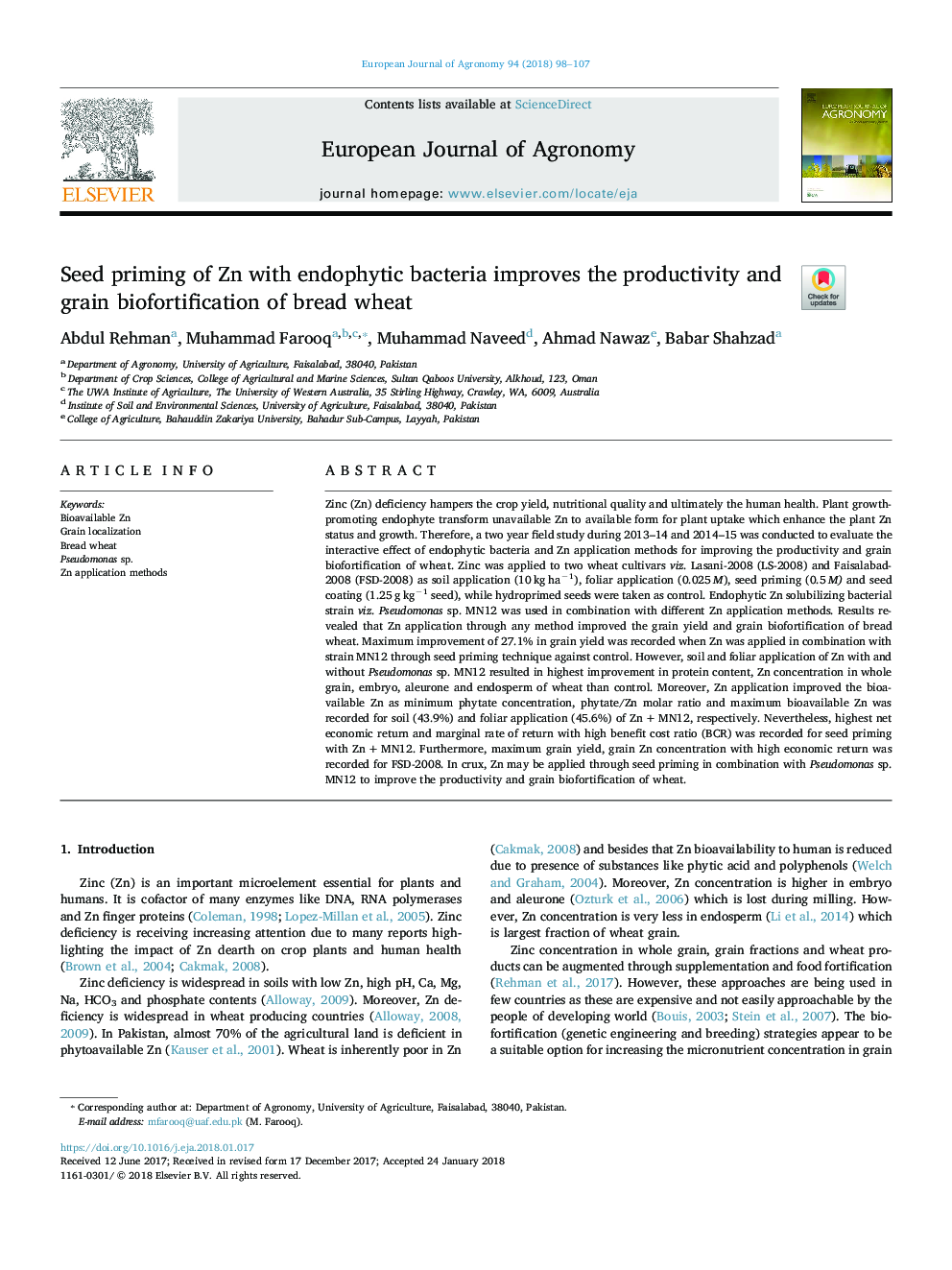| کد مقاله | کد نشریه | سال انتشار | مقاله انگلیسی | نسخه تمام متن |
|---|---|---|---|---|
| 8878971 | 1624430 | 2018 | 10 صفحه PDF | دانلود رایگان |
عنوان انگلیسی مقاله ISI
Seed priming of Zn with endophytic bacteria improves the productivity and grain biofortification of bread wheat
ترجمه فارسی عنوان
پر کردن دانه از روی با باکتری های اندوفیتی، بهره وری و تثبیت دانه از گندم نان را بهبود می
دانلود مقاله + سفارش ترجمه
دانلود مقاله ISI انگلیسی
رایگان برای ایرانیان
کلمات کلیدی
موضوعات مرتبط
علوم زیستی و بیوفناوری
علوم کشاورزی و بیولوژیک
علوم زراعت و اصلاح نباتات
چکیده انگلیسی
Zinc (Zn) deficiency hampers the crop yield, nutritional quality and ultimately the human health. Plant growth-promoting endophyte transform unavailable Zn to available form for plant uptake which enhance the plant Zn status and growth. Therefore, a two year field study during 2013-14 and 2014-15 was conducted to evaluate the interactive effect of endophytic bacteria and Zn application methods for improving the productivity and grain biofortification of wheat. Zinc was applied to two wheat cultivars viz. Lasani-2008 (LS-2008) and Faisalabad-2008 (FSD-2008) as soil application (10â¯kgâ¯haâ1), foliar application (0.025â¯M), seed priming (0.5â¯M) and seed coating (1.25â¯gâ¯kgâ1 seed), while hydroprimed seeds were taken as control. Endophytic Zn solubilizing bacterial strain viz. Pseudomonas sp. MN12 was used in combination with different Zn application methods. Results revealed that Zn application through any method improved the grain yield and grain biofortification of bread wheat. Maximum improvement of 27.1% in grain yield was recorded when Zn was applied in combination with strain MN12 through seed priming technique against control. However, soil and foliar application of Zn with and without Pseudomonas sp. MN12 resulted in highest improvement in protein content, Zn concentration in whole grain, embryo, aleurone and endosperm of wheat than control. Moreover, Zn application improved the bioavailable Zn as minimum phytate concentration, phytate/Zn molar ratio and maximum bioavailable Zn was recorded for soil (43.9%) and foliar application (45.6%) of Znâ¯+â¯MN12, respectively. Nevertheless, highest net economic return and marginal rate of return with high benefit cost ratio (BCR) was recorded for seed priming with Znâ¯+â¯MN12. Furthermore, maximum grain yield, grain Zn concentration with high economic return was recorded for FSD-2008. In crux, Zn may be applied through seed priming in combination with Pseudomonas sp. MN12 to improve the productivity and grain biofortification of wheat.
ناشر
Database: Elsevier - ScienceDirect (ساینس دایرکت)
Journal: European Journal of Agronomy - Volume 94, March 2018, Pages 98-107
Journal: European Journal of Agronomy - Volume 94, March 2018, Pages 98-107
نویسندگان
Abdul Rehman, Muhammad Farooq, Muhammad Naveed, Ahmad Nawaz, Babar Shahzad,
